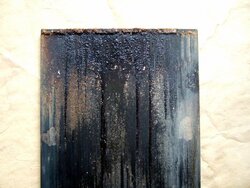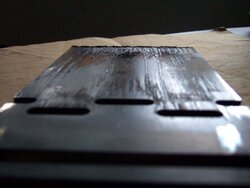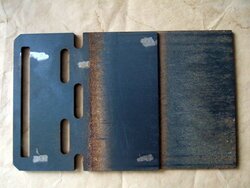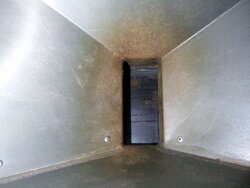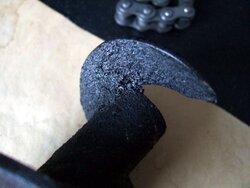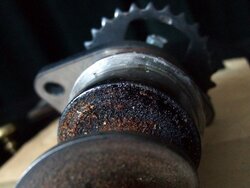Wow! This is really generating lots of discussion. I like it. Well, I don't like having a malfunctioning stove, but I do like having so many bright minds at work on this problem. All suggestions and thoughts are very good, but so far we are coming up empty. The feed rate is set at 5, but I did try setting it at 6, which is the maximum possible. No joy. The room temperature probe is most likely fine as it is nothing more than a thermister on a long wire. I tried unplugging it and I get a 4 blink error with it unplugged in room temperature mode. To recap, I did try running in stove temp mode and still got a 6 blink shut down, so I think we can let go of the room temp probe for the moment. I would love to get a hold of the diagnostic tool that reads all the signals the control board has to work with. That would be JUST the ticket for me. I have spent much time professionally troubleshooting complex signal processing software (on Voice over IP phones for example) and would be very comfortable using such a device to troubleshoot. I just feel we are flying blind here without knowing what exactly sets the 6 blink code. Seems like there are several paths to it (logically speaking). One is when the exhaust temp is too low for a given feed rate (I am guessing here, but I think it's a good guess), the other is perhaps when the room temperature does not increase when the exhaust temperature reads high enough (???). I am sure there are other possibilities. If I saw the data I would be able to deduce a lot more than I can now. Anyway, this is neither here nor there as no one has access to these diagnostic tools, it seems, except the Harman techs. So, we'll have to do it the hard way, I guess. Here are some more observations that I have not yet posted.
The stove seems to run fine until there is a lot of carbon build-up in the pot. I scrape the build-up, but not every day. Maybe I should do it every day.
In low heat regime there seems to be more build-up created. This may be my imagination, though. I do get a carbon ridge just around the lowest holes in the pot. The ones around the igniter. I took the igniter off and poked the holes out to make sure everything was clean. I noticed that the row of holes near the igniter does not go all the way across the pot. There are just holes half way across. Only to where the igniter is. I assume those are the special igniter holes, though they do participate in normal combustion. I am thinking that they get clogged up easily, perhaps. Just a thought. Maybe could use some more holes? I am not against drilling the burn pot.
I notice that the glass has a two dark soot spots way on the bottom left. You know where the air wash holes are. Well the two leftmost air wash holes seem to not be effective and I get two spots the size of thumb prints. Can this mean a leaky glass seal? Doesn't seem that way, but what do I know?
I get some smoke in the hopper when I open it to refill the pellets. I pulled the auger before and noticed nothing unusual about the auger. The tip of it was pretty dark and sooty and even a bit sticky, but it seems normal as it is right there in the fire. Not sure if the smoke in the hopper is a big deal. I think it's pretty normal seeing how the hopper is right above the burn pot and there is an opening from the burn pot (via auger and the flat steel plate above it that moves back and forth as the auger turns). So I am not sure this of any concern. Thoughts?
Next thing on my mind is the combustion motor. Any way to test it? It may be intermittently shorting out in the windings and becoming weak SOMETIMES, but not always. The stove seems to be from 2006, but I am not sure, it may be a little older than that. It is not super old, though. Thoughts on the combustion motor?
Thanks again!
P.S. Fortran was my second programming language, first being Basic. Used Fortran while working at a power utility company in Massachusetts (New England Electric in those days, now National Grid). So, no worries dating oneself
The stove seems to run fine until there is a lot of carbon build-up in the pot. I scrape the build-up, but not every day. Maybe I should do it every day.
In low heat regime there seems to be more build-up created. This may be my imagination, though. I do get a carbon ridge just around the lowest holes in the pot. The ones around the igniter. I took the igniter off and poked the holes out to make sure everything was clean. I noticed that the row of holes near the igniter does not go all the way across the pot. There are just holes half way across. Only to where the igniter is. I assume those are the special igniter holes, though they do participate in normal combustion. I am thinking that they get clogged up easily, perhaps. Just a thought. Maybe could use some more holes? I am not against drilling the burn pot.
I notice that the glass has a two dark soot spots way on the bottom left. You know where the air wash holes are. Well the two leftmost air wash holes seem to not be effective and I get two spots the size of thumb prints. Can this mean a leaky glass seal? Doesn't seem that way, but what do I know?
I get some smoke in the hopper when I open it to refill the pellets. I pulled the auger before and noticed nothing unusual about the auger. The tip of it was pretty dark and sooty and even a bit sticky, but it seems normal as it is right there in the fire. Not sure if the smoke in the hopper is a big deal. I think it's pretty normal seeing how the hopper is right above the burn pot and there is an opening from the burn pot (via auger and the flat steel plate above it that moves back and forth as the auger turns). So I am not sure this of any concern. Thoughts?
Next thing on my mind is the combustion motor. Any way to test it? It may be intermittently shorting out in the windings and becoming weak SOMETIMES, but not always. The stove seems to be from 2006, but I am not sure, it may be a little older than that. It is not super old, though. Thoughts on the combustion motor?
Thanks again!
P.S. Fortran was my second programming language, first being Basic. Used Fortran while working at a power utility company in Massachusetts (New England Electric in those days, now National Grid). So, no worries dating oneself



